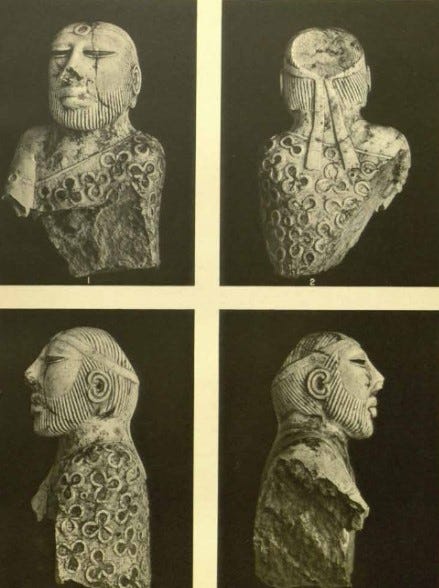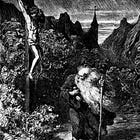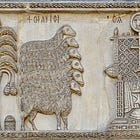Hi all - my apologies for the downtime, life, unfortunately, continues to be fairly rough for me. I am doing by best but staying on top of all of my obligations during my move (which still isn’t complete), while trying to access healthcare,has been an enormous effort, and with classwork on top of that moreso - much less mantaining output here. My mental health as well as my physical health has taken a significant hit. But, finally, here’s some more - a bit more rough this time, as finding time to write, edit and polish has been difficult, but I hope that my ideas are at least a little cogent - much of the prior material was already pretty solid, but here is where stuff got a bit more draft-ish, and while part of the rest of what I have to say is fully written, it will need substantial culling for this format, and the conclusion is still to be written. The former, mostly fully written part is on Agamben’s treatment of Benjamin, but will be cut down to deal solely with Kafka, and the questions of law, tradition and transmission, then the plan is that the conclusion will return to Heidegger, hermeneutics and the question of being, by way of the critique of Heidegger leveled by another of his students, the Japanese Philosopher Tanabe Hajime. So I have an idea of what I want to do here, it is just a question of it actually getting done. G-d willing it will be, however slow it may be.
previous installments can be read here:

The present cultural world that Agamben describes is assumed to be uniform, and that uniformity shared with his readers – we live in a particular age, with particular qualities, that represents a particular culture which is tacitly assumed to be universal – and which is the result of a developmental process. But, further, the ray of hope for transformation exists within this developmental framework, in the form of (Lutheran-Pauline) messianism, which provides a kind of escape hatch or emergency brake. While this is a Benjaminian motif, the means by which both the catastrophe of the present and the escape route are conceived are explicitly mythic. As previously noted, the “homogeneity” of the catastrophe is “constituted” by the thought that describes it, reaffirming, perhaps unintentionally but nonetheless significantly his earlier-stated desire that “If man could appropriate his historical condition […] he could exit his paradoxical situation […] and to turn history into myth.”1
This production of modern myth, as previously noted, runs directly contrary to Benjamin’s attempt to break humanity out of a soporific trance maintained by a collectively constructed stratum of already-mythical cultural detritus, which is subconsciously determinative of the modern human’s self-understanding.2 On this point I wish to argue two, related things: Firstly, that Agamben is both subject to and productive of the same cultural malaise that Benjamin identifies, and that, secondly, this leads to a misidentification of a crucial element of Benjamin’s thought regarding theology and the transmission of tradition.
The first of these points can be clearly identified from the method explicated in The Signature of All Things. By way of ideas drawn from (among others) Franz Overbeck and Georges Dumézil the investigation of the past and its constitutive power over the present the process of investigation becomes solipsistic and self-justifying, with the criteria that would operate as correctives against error excluded. In dealing with the past, Agamben is not dealing with history per se but rather with “the past that will have been” after the work of constructing it has been completed, laden with metaphysical and soteriological language.3 Symptomatic of this is Agamben’s reproduction of the arch-conservative Georges Dumézil’s post-hoc rationalization of his failure to prove what was, initially, very much a historical hypothesis, by retreating into a kind of cultural essentialism. Dumézil initially proposed that the prehistoric Proto-Indo-Europeans had concrete, caste-based political system of Priests, Warriors and Artisans, but as evidence for that dried up he modified and reduced this hypothesis to a cultural essence, embodied to greater or lesser extents in descendant societies.4 It is in the face of the inability to empirically assert his thesis that Dumézil retreats and simultaneously expands his position – this division exists trans-historically as a Indo-European mentality or Weltanschauung, embodied more or less in the psyche and culture of the various Indo-European peoples. Agamben presents this as analogous to his own method of philosophical “archaeology,” the uncovering of an archē, where Dumézil is approvingly quoted as describing “an ideal and, at the same time, a way of analyzing and interpreting the forces that determined the course of the world and the life of men.”5 Of the hypothesis being described, Arnaldo Momigliano writes:
If there are other Indo-European societies in which the emphasis on the so-called trifunctional structure is greater than in Rome, then the first question to ask is whether the reason is not to be found inside that society rather than in the Indo-European original society. Feudal society fulfills Dumézil’s requirements more obviously than the Roman society. But it fulfills them because of the combination of Christianity with feudalism.6
Dumezil’s pseudonymous writings for conservative nationalist venues in the late 1930s are widely known, in which he praised Mussolini, though opposed Hitler. There is little dispute about his political leanings – he has been described as “profascist but anti-Nazi” and maintained relationships with many figures in the conservative-nationalist right, through the War and into the post-War period. What is disputed by some is the relationship of this to his scholarship, but a careful diachronic reading of the revisions made to his interpretation of specifically Germanic myth by Bruce Lincoln reveals that his interpretation of these mythic motifs both parallels his political positions and does so in a way that deviates from the expected interpretation given his commitment to his tri-functional hypothesis and its relation to the domains of the deities represented. From this Lincoln concludes what many on the right also conclude: Dumezil’s academic work is explicitly political; but the points on which he differs from his more crude admirers are both his methodological rigour and his subtlety of self-expression: his works reflect “the contradictory impulses of those on the French right in the late 1930s” but are expressed in “the intricate scholarly code he developed, through which he made the arcane data of Indo-European mythology serve as the vehicles for his views.”7 Thus we can see that even in the investigation of the “fringe of ultra-history” the comparative and academic study of myth is itself distinctly modern, as are its claims to transhistorical truth which themselves manifest as functionally parallel to the myth of the past. This is something which Walter Benjamin was keenly aware of, as can be seen from his study of Johann Jakob Bachofen.
Agamben appears to accept Dumézil’s identification of an Indo-European “ideology,” presenting it as a precursor to his own thought, and asserting that his philosophical archaeology works similarly to identify an “atemporal metahistorical structure” which is “a force working in history, exactly as the Indo-European language expresses first of all a system of connections among historically accessible languages.” Of this archē Agamben writes:
it is something that is necessarily presupposed as having happened but that cannot be hypostatized into an event in a chronology—it can eventually render historical phenomena intelligible.8
This is further tied to the phenomenon of anthropogenesis – for Agamben the becoming-human of Homo Sapiens in the acquisition of language – in which the Indo-European tradition of oaths is tied to the structure of language itself and its presuppositional, originary split between subject and object. These are not truly historical claims – indeed, for Agamben they are “always under way, because Homo sapiens never stops becoming man, has perhaps not yet finished entering language,” but they are part of a broad narrative of origins.9 For Agamben “anthropogenesis” leads to Dumézil’s assumed-trifunctional social order of Proto-Indo-European society, which leads into the classical world, Judaism, Christianity, and modernity as the continual establishment of the political order of the West. Even if this narrative is not, strictly speaking a historical claim, Agamben’s reproduction of it and its mythic, etiological structure means something, particularly given its implicitly political content.
Articulating the past historically […] means appropriating a memory as it flashes up in a moment of danger. Historical materialism wishes to hold fast that image of the past which unexpectedly appears to the historical subject in a moment of danger. The danger threatens both the content of the tradition and those who inherit it.
[…]
Whoever has emerged victorious participates to this day in the triumphal procession in which current rulers step over those who are lying prostrate. According to traditional practice, the spoils are carried in the procession. They are called "cultural treasures" […] There is no document of culture which is not at the same time a document of barbarism.
[…]
The Social Democrats preferred to cast the working class in the role of a redeemer of future generations, in this way cutting the sinews of its greatest strength. This indoctrination made the working class forget both its hatred and its spirit of sacrifice, for both are nourished by the image of enslaved ancestors rather than by the ideal of liberated grandchildren.
[…]
We know that the Jews were prohibited from inquiring into the future: the Torah and the prayers instructed them in remembrance. This disenchanted the future, which holds sway over all those who turn to soothsayers for enlightenment.10
If we return to Agamben’s quotation of Coleridge reproduced far earlier in this essay, to understand a writers work it is necessary to “understand a writer’s ignorance,” with “ignorance” here being “what the author had to leave unsaid, undeveloped, or as a potential.”11 What is undeveloped here is the tacit assumption of a shared, universal tradition inherited by both Agamben and his presumed reader, which stretched from Dumézil’s “fringe of ultrahistory” in which Homo Sapiens acquired language (tacitly assuming that no other hominins did), through Proto-Indo-European to classical Greece and Rome, the birth of Christianity, Augustine, Aquinas and Kant, and Carl Schmitt, among others. That which is other to this tradition is, largely, noted in passing if at all, or assumed to reflect the same core ideas – such as a messiah who is the telos and end of the law – less partisan, perhaps, than Dumézil’s “Indo-European ideology,” but similarly problematic. While few would dispute that Agamben is, largely, a man of the left, and has been for most of his life, this feature of his work betrays a distinct and profound intellectual conservativism. He may not be particularly sympathetic to this Classical, Occidental history whose broad strokes he outlines, but nevertheless he inhabits it and is at home within it – so much so, in fact, that in those brief moments when he steps outside it he either sees the same things he already knows regardless of whether they are actually there or not, or expresses a fairly easily identifiable discomfort, falling back from the intricacies of Latin and Greek grammar and lexicography and exclusively relying on translation (as he does with Hebrew and Aramaic, of which he lacks fairly basic knolwedge), and often translations that are very, very old, dating from the 19th Century through to the mid-20th Century, the point after which, in his judgement, much of the humanities and social sciences went into an unabated decline.12
Thus, in a way, the archē that Agamben identifies as a trans- or meta-historical force present within and determinatively bearing on the present is real, however what it determines is as much Agamben’s interpretation of the present as it is the broader reality he attempts to describe. Agamben is correct that “the archē of archaeology is what will take place, what will become accessible and present, only when archaeological inquiry has completed its operation.”13 Agamben’s operation reveals the determinative effect of this archē, but the effect is on his own thought, not the world. By accepting this epistemic model and epic, developmental mode of history as given, and in turn predetermining that that which he is uncovering is metaphysical rather than epistemic, Agamben mistakes the finger pointing at the moon for the moon itself.
Awakening as a graduated process that goes on in the life of the individual as in the life of generations. Sleep its initial stage. […] Every epoch has such a side turned toward dreams, the child's side. [...] whereas the education of earlier generations explained these dreams for them in terms of tradition, of religious doctrine, present-day education simply amounts to the distraction of children. […] What follows here is an experiment in the technique of awakening. An attempt to become aware of the dialectical – the Copernican – turn of remembrance.14
This leads inexorably to a particular conclusion. The episteme under which and through which Agamben operates – and which his thought, wittingly or not, perpetuates – is, in fact, an apparatus of the same kind his thought is meant to render inoperative. Agamben describes an apparatus as:
a heterogeneous set that includes virtually anything, linguistic and nonlinguistic, under the same heading: discourses, institutions, […] philosophical propositions, and so on […] The apparatus […] is always located in a power relation. […] As such, it appears at the intersection of power relations and relations of knowledge.15
This definition of an apparatus is extended from Foucault to include “literally anything that has in some way the capacity to capture, orient, determine, intercept, model, control, or secure the gestures, behaviors, opinions, or discourses of living beings” and between apparatuses and living beings is their place of intersection, in which the apparatus bears on the being and this relation constitutes said being’s subjectification or desubjectification.16 One can see the results of this apparatus’ determination of Agamben’s thought throughout the rest of the essay I have been quoting from. This essay is written during the composition of The Kingdom and the Glory and provides preliminary remarks regarding its thesis. Here, again a monolithic, trinitarian Christianity determines the present, and, in Schmittian fashion, its conceptual structure determinatively undergirds modern, secular Western society and its institutions.17
What is telling, here, is not only the connection of trinitarian oikonomia to basically every aspect of contemporary, Western society and its means of social reproduction, but that this is tied to the production of particular types of political subjectivity. If the actual social situation was determined in such a way as Agamben describes, then the social body of the West (and, it would seem, those living under its hegemony) would be subject to a very particular kind of subjectification, which would (of course imperfectly) produce a particular kind of subject. Indeed, the consequences of this would look much like what he described far earlier in The Coming Community:
If we had […] to conceive of the fortunes of humanity in terms of class, then today we would have to say that there are no longer social classes, but just a single planetary petty bourgeoisie, in which all the old social classes are dissolved: The petty bourgeoisie has inherited the world and is the form in which humanity has survived nihilism.
[…]
That which constituted the truth and falsity of the peoples and generations that have followed one another on the earth – differences of language, of dialect, of ways of life, of character, of custom, and even the physical particularities of each person – has lost any meaning for them and any capacity for expression and communication.18
If this were true it could only be so in a very limited manner. But for Agamben there is no possibility for any authentic, real or meaningful social particularly or authentic engagement with culture and tradition under modernity – all has already been subsumed under a universal nihilism, to the point there is no longer even such thing as social class – the experiential and social position of any individual in any situation is, essentially, empty. This leads to one of the most troubling passages in Agamben’s entire oeuvre:
Selecting in the new planetary humanity those characteristics that allow for its survival, removing the thin diaphragm that separates bad mediatized advertising from the perfect exteriority that communicates only itself – this is the political task of our generation.19
While much of the language in which Agamben’s political thought had substantially transformed in the decade and a half between The Coming Community and “What is an Apparatus?” the underlying perspective on the social makeup of the world appears to have changed little – nihilism is absolutely determinative of contemporary existence, and no cultural difference or social identity is significant enough to introduce any meaningful variation into this system. In order to affirm this position one does not only have to avert one’s eyes from the slums and sweatshops of the Global South to insist on classlessness, and from the diverse means of cultural expression and transmission that populate most urban centres, but avert one’s gaze even from those politicians who decry such as a cultural poison while simultaneously asserting the culture of the populations they despise do not really hold on to anything significant. It is a similar thought that underlies Homo Sacer:
All societies and all cultures today (it does not matter whether they are democratic or totalitarian, conservative or progressive) have entered into a legitimation crisis in which law (we mean by this term the entire text of tradition in its regulative form, whether the Jewish Torah or the Islamic Shariah, Christian dogma or the profane nomos) is in force as the pure “Nothing of Revelation.” But this is precisely the structure of the sovereign relation, and the nihilism in which we are living is, from this perspective, nothing other than the coming to light of this relation as such.20
While this thesis is extrapolated from Geshom Scholem’s reading of Kafka (to which Benjamin strongly objects), it is merely asserted – and this assertion pays no heed to the motion from one realm (the interpretation of early 20th Century German-Jewish modernist literature) to a cultural principle applying universally (“…it does not matter whether…”) one hundred years later. Agamben’s ensuing analysis, explicating the world and Scholem and Benjamin’s reading of Kafka simultaneously, also misconstrues the substance of the two friends’ disagreement – on the nature of law, and the nature of the various literary phenomena which, at least on Benjamin’s part are highly particular – none of this is explicated, despite Benjamin’s at times pained effort to explain what he means to his friend. This is not to say that this conversation has no political implications – it does – but rather than neither the literary-critical specificity of the discussion nor its implicit political content are what Agamben draws from it. Agamben’s conclusions are entirely determined by his prior convictions: his Heideggerianism, his uptake of the Schmittian thesis on political theology and secularization, and his grounding in the tradition of classical, European culture. The capture of Agamben’s thought by these totalizing and universalizing frameworks, which determine the scope of his thought prior to its articulation mean that, in terms of culture, tradition and the transmission of such are singular, and their transmission has failed to maintain meaning – they are “in force without significance” and have been emptied out by the triumph of modern nihilism – and this leads inexorably to a fundamental misunderstanding of key elements in Benjamin’s thought, most clearly represented in his reading of Benjamin’s thought on Kafka.
Agamben, "What is a Paradigm?." 18; Agamben, "The Melancholy Angel." 114.
Agamben, "Philosophical Archaeology." 106 and following.
The tri-functional division of “Aryan” PIE society was clearly a historical hypothesis in 1938 (not “around 1950” as claimed in ibid. 92) and influenced by Dumézil’s political conservativism, including sympathy for Mussolini’s regime and nostalgia for Feudalism. The material that Agamben cites from 40 years later regarding “fringe-ultra-history” as opposed to regular historiography is transparently a post-hoc attempt to preserve the hypothesis in a different form despite the face of growing bodies of evidence that challenge it. Ibid. 91-2; Sacrament of Language, in Agamben, Omnibus. 305, 307-8, 312-4. See Arnaldo Momigliano, "Georges Dumézil and the Trifunctional Approach to Roman Civilization," History and Theory 23, no. 3 (1984), https://doi.org/10.2307/2505078
Agamben, "Philosophical Archaeology." 92.
Momigliano, "Georges Dumézil and the Trifunctional Approach to Roman Civilization." 329.
Bruce Lincoln, Theorizing myth : narrative, ideology, and scholarship (Chicago: University of Chicago Press, 1999). 121-137. Given the material that Lincoln treats here relates specifically to law, sovereignty and both Nazism and Italian fascism one would think that this work of Dumézil’s would be directly relevant to Agamben’s overarching thesis, however it is nowhere cited. A less than charitable reader may suspect that this is because the veiled critique of Nazism that Dumézil levels is tied to a disorder in the distribution of legal power relative to the stable and ordered Indo-European ideal represented by trifunctionalism. Hitler’s power is analogous to an anarchic deviation from this normative system, the degradation of its structural form rather than a trans-historical structural feature. This selective reading mirrors the selective and presuppositional elements Lincoln identifies in Dumézil himself.
Sacrament of Language, in Agamben, Omnibus. 308.
Ibid. 309.
Benjamin, "Concept." 391-7.
Agamben, "What is a Paradigm? (EGS lecture)."
This conservativism is primarily implicit and revealed via Agamben’s citations, in both character and date, but becomes explicit in multiple places, exemplary of which are statements like “Before entering a stage of decline, the history of the human sciences saw, during the first half of the twentieth century, a decisive acceleration…” Agamben, "Philosophical Archaeology." 108.
Ibid. 105-6. Note the clear rejection of the core principles of Benjamin’s historiographical methodology following this.
Benjamin, Arcades., K1,1; 388.
Giorgio Agamben, "What is an apparatus?," in What is an apparatus? : and other essays, Meridian Crossing Aesthetics (Stanford: Stanford University Press, 2009). 2-3.
Ibid. 14-17.
Ibid. 8-12, 22-4.
Giorgio Agamben, The coming community, Theory out of bounds, (Minneapolis: University of Minnesota Press, 1993). 63-4.
Ibid. 65.
Homo Sacer, in Agamben, Omnibus. 45-6.









